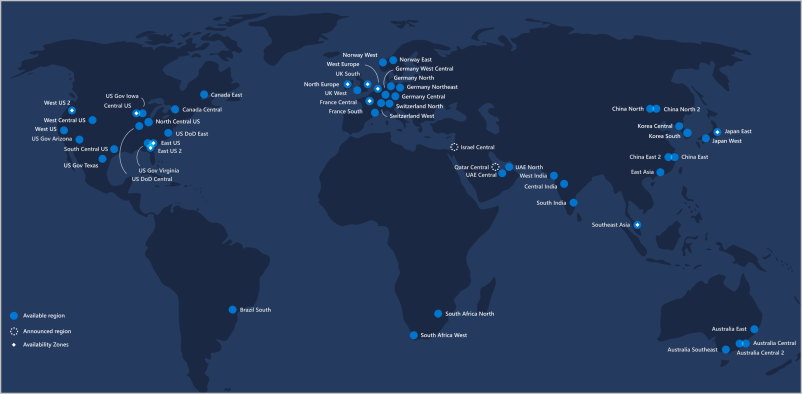Azure Data Centers
10 Jan 2023
- Azure provides more than 100 redundant & secure facilities worldwide linked with a network.
- Allows you to
- gain global reach with local presence
- keep your data secure and compliant with local laws
-

- You can pick the region and sometimes availability zone you want resources deployed into.
- ❗You can’t select a specific datacenter or location within a datacenter.
Regions
- Regions = Contains at least one, but often multiple datacenters that are nearby and networked together with a low-latency network.
- Azure assigns and controls the resources within each region to ensure workloads are appropriately balanced.
- E.g. West US, Canada Central, West Europe, Australia East, and Japan West.
- ❗Some services or virtual machine features are only available in certain regions, such as specific virtual machine sizes or storage types.
- Azure regions as of February 2020:
- 💡Regions provide better scalability, redundancy, and preserves data residency for your services.
- Read more: Azure regions
Special regions
- For compliance or legal purposes.
- Azure Government
- US DoD Central, US Gov Virginia, US Gov Iowa and more
- 📝 Physical and logical network-isolated instances of Azure for US government agencies and partners.
- China East, China North and more
- Unique partnership between Microsoft and 21Vianet
- Microsoft does not directly maintain the datacenters.
Geographies
- Each region belongs to a single geography
- Defined by geopolitical boundaries or country borders.
- Has specific service availability, compliance, and data residency/sovereignty rules applied to it
- Fault-tolerant to withstand complete region failure through their connection to dedicated networking infrastructure
- 📝 Fault-tolerance: App ability to self-detect and correct all types of problems in its environment
- Data residency
- Defines the legal or regulatory requirements imposed on data
- Based on the country or region in which it resides
- 💡 An important consideration when planning out your application data storage.
- Geographies are broken up into the following areas
- Americas
- Europe
- Asia Pacific
- Middle East and Africa
- Read more: Azure geographies
Availability Zones
- 📝 Physically separate datacenters within an Azure region.
- 💡 Allows you to make applications highly available through redundancy.
- Replicate your compute, storage, networking, and data resources in other zones.
- Costs more
- Primarily for VMs, managed disks, load balancers, and SQL databases
- Zonal services: Pin resource to a specific zone.
- Zone-redundant services: Replicates automatically across zones.
- Have independent power, cooling, and networking
- Set up to be an isolation boundary
- If one zone goes down, the other continues working
- Identified as 1-2-3
- Logically mapped to the actual physical zones for each subscription independently.
- Availability Zone 1 in a given subscription might refer to a different physical zone than Availability Zone 1 in a different subscription.
- Connected through high-speed, private fiber-optic networks.
- ❗There are regions that do not support (multiple) availability zones
Region Pairs
- Each Azure region is always paired with another region within the same geography
- E.g. West US paired with East US, and South East Asia paired with East Asia
- Pairs are at least 300 (≈ 500 km) miles away.
- Allows for the replication of resources, e.g. virtual machine storage
- Some services offer automatic geo-redundant storage using region pairs.
- Reduce the likelihood of interruptions to both regions
- E.g. natural disasters, civil unrest, power outages, or physical network outages
- If one region fails, services automatically fail over to the other region in its region pair.
- Data continues to reside within the same geography as its pair (except for Brazil South) for tax and law enforcement jurisdiction purposes.
- If there’s an extensive Azure outage =>
- One region out of every pair is prioritized to make sure at least one is restored as quick as possible,
- Planned Azure updates are rolled out to paired regions one region at a time to minimize downtime and risk of application outage.

